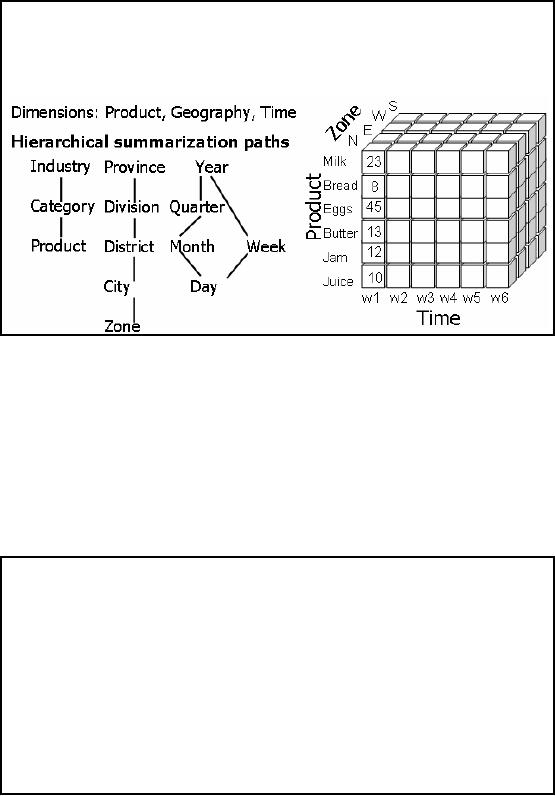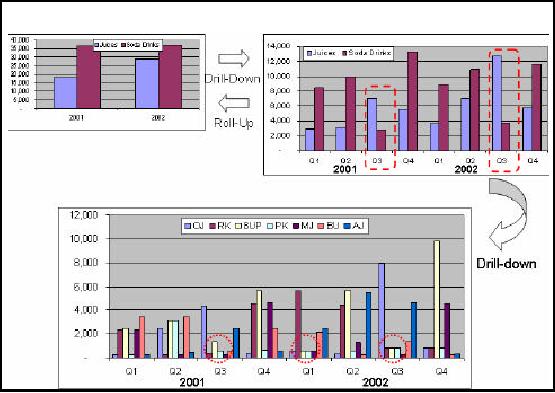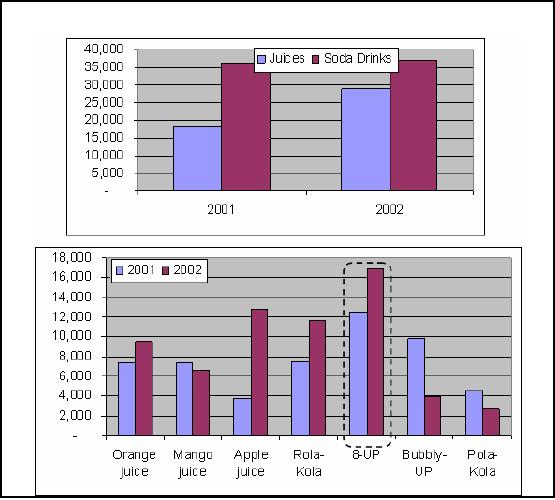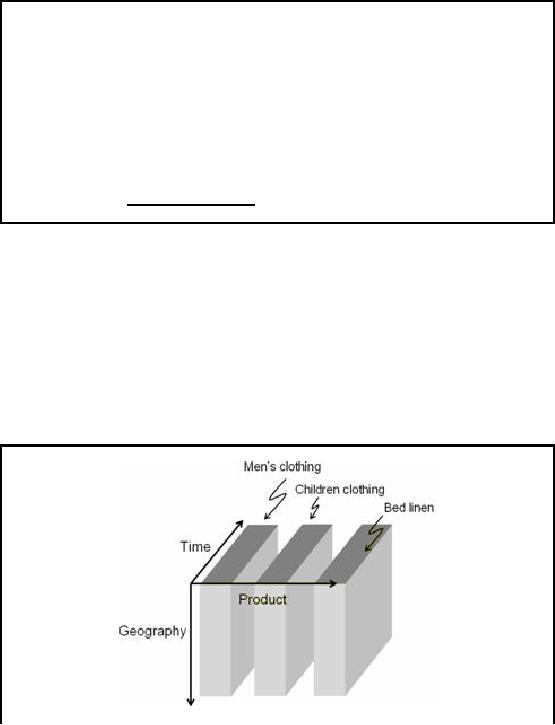 |
OLAP Implementations: MOLAP, ROLAP, HOLAP, DOLAP |
| << Online Analytical Processing OLAP: DWH and OLAP, OLTP |
| ROLAP: Relational Database, ROLAP cube, Issues >> |

Lecture-11:
Multidimensional OLAP
(MOLAP)
OLAP
Implementations
1. MOLAP:
OLAP implemented
with a multi-dimensional data
structure.
2. ROLAP:
OLAP
implemented with a relational
database.
3. HOLAP:
OLAP
implemented as a hybrid of MOLAP
and ROLAP.
4. DOLAP:
OLAP
implemented for desktop
decision support environments.
MOLAP
physically builds "cubes" for direct
access - usually in the proprietary
file format of a
multi-dimensional
database (MDD) or a user
defined data structure. therefore
ANSI SQL is not
supported.
ROLAP or a
Relational OLAP provides access to
information via a relational database
using
ANSI
standard SQL.
HOLAP
provides a combination of relational database
access and "cube" data
structures within a
single
framework. The goal is to get
the best of both MOLAP and
ROLAP: scalability (via
relational
structures) and high performance
(via pre -built
cubes).
DOLAP
allows download of "cube"
structures to a desktop platform
without the need for
shared
relational or
cube server. This model facilitates a
mobile computing paradigm. DOLAP
is
particularly useful
for sales force automation
types of applications by supporting
extensive slide
and
dice. A DOLAP implementation needs to be
much more efficient in disk
and memory
utilization
than typical server implementations
because computing power is often
limited on a
laptop
computer.
MOLAP
Implementations
OLAP
has historically been implemented
using a multidimensional data structure
or "cube".
�
Dimensions
are key business factors
for analysis:
� Geographies
(city, district, division, province,...)
� Products
(item, product category,
product department,...)
� Dates
(day, week, month, quarter,
year,...)
�
Very
high performance achieved by O(1) time
lookup into "cube" data
structure to
retrieve
pre_aggregated results.
Multi-dimensional
databases (MDDs) typically use
proprietary file formats to store
pre -
summarized
cube structures. There are
dozens of vendors who provide
MDD products. Essbase
from
Hyperion and Powerplay from
Cognos are some examples of
market share leaders in
this
space.
Some RDBMS vendors have also
begun packaging MDD
capabilities into their
product
69

offerings.
Express from Oracle (acquired
from IRI) and the
MOLAP Store in Microsoft's
OLAP
Server
architecture (acquired from
Panorama) are examples of
products from RDBMS
vendors.
MOLAP
cubes are built around
dimensions, as corresponding to each
dimension is the index of
the multi-dimensional array
data structure. Meaning, if there
are four dimensions, then
the data
will be
stored in a four dimensional
array i.e. with four
indexes i, j, k and l. The
other significance
of dimension
from the business point of
view are the key
factors they correspond to,
typically
dimensions
are the features on which
the WHERE clause is
executed. Some examples
of
dimension are
geography, time, products
etc. Note that typically
dimensions have hierarchies,
for
example
geography dimension has the hierarchy of country,
then province, then
division, district,
city and
zone as discussed in the
last lecture.
The performance
in a MOLAP cube comes from
the O(1) look-up time for
the array data
structure.
Recall that to access an array,
only the indexes are
required i.e. there is no scanning
of
the array
(like a file data
structure), there is no hashing it a
constant access time
operations,
similar to a
random access memory (or RAM).
The only time the time complexity
goes beyond
O(1) is
when the cube size is so
large that it can not fit in
the main memory, in such a
case a page
or a block fault
will occur.
MOLAP
Implementations
�
No standard
query language for querying
MOLAP
- No
SQL !
�
Vendors
provide proprietary languages allowing
business users to create
queries that
involve
pivots, drilling down, or
rolling up.
- E.g. MDX
of Microsoft
-
Languages
generally involve extensive
visual (click and drag)
support.
-
Application
Programming Interface (API)'s also
provided for probing the
cubes.
As it should be
clear by now that, in a
MOLAP environment there are
no tables, there are
no
traditional
relational structures, hence ANSI
SQL can not be used. As a
matter of fact, there is
no
standard query
language for querying a
MOLAP cube. The cube is
sometimes probed by a
complex
mapping mechanism that maps
the user requirements into a
set of indices, which
are
then
used to retrieve the
aggregate from the
corresponding matrix location. However,
vendors
have
come up with proprietary languages
for non IT business users,
the most popular being MDX
by Microsoft.
These "languages" are graphical
environments where the business users
can click
on actions
and perform drag-and-drop operations to
provide input to retri eve
data/information
from
the cube. APIs are also
available in the market for
programming cube data retrieval by
more
experienced
programmers for running of
complex quires. But none of
these approaches use
SQL.
70

Aggregations
in MOLAP
�
Sales
volume as a function of (i)
product, (ii) time, and
(iii) geography
�
A cube
structure created to handle
this.
Figure-11.1:
Filled cube
Figure11.1:
Aggregation and a MOLAP
cube
As already
stated a number of times, in a Data
Warehouse decision support
environment we are
interested in
the big picture, we want to
look at the data from a
macro level instead of the
micro
level.
For a macroscopic view
aggregates are used. In this
example we look at the sales
volume
i.e.
number of items sold as a
function of product, time and
geography. Note that all
three of them
are
dimensions. The proceed with
the analysis, a cube
structure will be first
created such that
each
dimension of
the cube will correspond to
each identified dimension,
and within each
dimension
will be
the corresponding hierarchy.
The example further shows
how the dimensions are
"rolled -
out"
i.e. Province into divisions, then
division into district, then
district into city and finally
cities
into
zones. Note that weeks
could be rolled into a year
and at the same time
months can be rolled
into
quarters and quarters rolled
into years. Based on these
three dimensions a cube is
created and
shown in
figure -11.1.
Cube
Operations
�
Rollup:
summarize data
� e.g.,
given sales data, summarize
sales for last year by
product category and
region
�
Drill
down: get more
details
� e.g.,
given summarized sales as above,
find breakup of sales by city
within each
region, or
within Sindh
�
Slice
and dice: select and
project
� e.g.:
Sales of soft -drinks in Karachi
during last quarter
�
Pivot:
change the view of
data
71

The
word cube is synonymously
used with a MOLAP, therefore,
when we talk of cube
operations
we are
never referring to SQL based
querying, instead how we view
the data stored in a
cube.
There
are four fundamental cubes
operations which are (i)
rollup (ii) drill down
(iii) slice and
dice
and
(iv) pivoting. In the rollup
operation the level of
aggregation is increased i.e.
data is presented
at a higher
level of aggregation with
less detail. For example
while looking at the weekly
sales
data,
the decision maker decides
to look at the monthly sales
data, this is a rollup
operation. On
the other
hand, while looking at the
weekly sales data, the
decision makers wants to
look at the
higher
level of detail thus he/she
drills down and looks at
the daily sales data or
was looking at
the
division level of the sales
data, and drills down
into district level sales
data by looking at
the
sales in
different cities corresponding to a
district, among one of the
many districts present in
a
division.
Slice and dice is a combination of
looking at a subset of data
based on more than
one
dimension. As
shown sin the slide, a
combination of geography and time is used
to look at part of
the
cube across more than a
singe dimension. Finally
pivoting is changing the
view of the data
i.e.
replacing the
dimension across the (say)
x-axis. This will become
clear when we look at
specific
examples in
the following slides.
Querying
the Cube
Figure-11.2:
Different cube
operations
Question:
Juices are selling well or
the sodas?
Looking at
the highest level summary,
with the lowest data
granularity, shows that the
sales of
Soda
Drinks are higher for years
2001 and 2002.
Question:
Which sodas are doing
well?
Just
clicking on the Sodas column
shows the second histogram. It
shows that the sales of
8-UP
cola
are highest in both years
i.e. 2001 and
2002.
72

Question:
Is 8-UP a clear
winner?
Flipping
the dimensions i.e. instead
of product on xaxis putting time on xaxis
and further
-
-
drilling
-down shows that there is a
trend of increasing sales of 8-UP, BUT
the sale is
alarmingly
down
during QTR3 in 2001 and QTR1
and QTR3 during
2002.
All of
the above information was
extracted by exploring 46 table
entries and three levels
of
aggregates.
The total exploration time took less than
3 seconds.
Question:
Why erratic sales of
8-UP?
This
may probably require exploring other
dimensions or their
combinations.
Querying
the Cube:
Pivoting
Fig-11.3(a)
Fig-11.3(b)
Figure-11.3:
Pivot cube
operations
This is a
good exa mple of pivoting. In
the first figure (11.3(a)),
along x-axis we have the
time
dimension,
y-axis is the sales volumes, but
volumes for the product are
under two categories
i.e.
juices
and soda drinks. By the
pivoting operation, the dimensions
are interchanged, and we
end
up with
having the product along the x
axis and the yearly
sales figures (i.e. time
dimension)
-
along
the y-axis. The purpose of
pivoting and other operations
are not just to provide a
set of
73

different
operations, but to enable the decision
maker to look at the data
from different
angles.
From
fig-11.3(a) it seems that
the sales of soda drinks are
up consistently through year 2001
and
2002, but
after pivoting and doing a
drilldown operation, we see that
the sales of apple juice
was
higher than all
soda drinks, except 8-UP, but the
sale of 8-UP was so high
both in years 2001 and
2002, that it
shot up the overall sales of
soda drinks. Thus all soda drinks
are not the winners;
actually
Pola -Kola has the
weakest sales of all.
MOLAP
Evaluation
Advantages
of MOLAP:
�
Instant
response (pre -calculated
aggregates).
�
Impossible to
ask question without an
answer.
�
Value added
functions (ranking, % change).
MOLAP
implementations with pre-defined cubes as
pre -aggregated data perform
very well when
compared to
relational databases, but often have
difficulty scaling when the
size of dimensions
becomes
large. The breakpoint is typically
around 64,000. Some
implementations are
also
limited to a
file size for the
cube representation that
must be less than 2GB
(this is less often an
issue
than a few years
ago).
Actually
the cubes are less
than 1% full.
MOLAP
Evaluation
Drawbacks of
MOLAP:
�
Long
load time ( pre -calculating
the cube may take
days!).
�
Very
sparse cube (wastage of
space) for high cardinality
(sometimes in small
hundreds).
e.g.
number of heaters sold in
Jacobabad or Sibi.
A MOLAP is in no
way a win -win situation, it
has its won intrinsic
pitfalls, which does not
make
it an overall
winner. The biggest drawback is
the extremely long time
taken to pre-calculate
the
cubes,
remember that in a MOLAP all
possible aggregates are
computed. The number of
aggregates
suffers from something called as
the "curse of dimensionality" i.e. as
the number of
dimensions
increases, the number of possible
agg regates increases exponentially,
this will be
further
clarified in an upcoming slide. Because
of long calculation times, cube
creation is a batch
process
and usually has the
lowest priority and
scheduled to be done late in
the night. This
actually turns
out to be a big mistake (as
we will discuss subsequently) as it
may so happen that
the
cube generation may not
actually take place, and
the decision makers are
presented with the
old
and stale data, and
they tend to lose faith in
the OLAP paradigm. Although
the number of
possible
aggregates is very large,
but NOT all the
aggregates may have values,
there can be and
will be quite a
few aggregates which will
have null values. For
example, many of the items
sold
in winter
are not sold in summer and
not even kept in the store
(and vice-a-versa). Consequently,
there
are no corresponding sales,
and if the cube is generated
that includes all the
items, there will
be many
null aggregates, resulting in a very
sparse cube. This will
result in requirement of large
74

amount of
memory, most of which would
be wasted. For these very
reasons cube compression
is
a hot area of
research and development. We will not
discuss it any
further.
MOLAP
Implementation Issues
Maintenance
issue: Every
data item received must be
aggregated into every
cube
(assuming "to-
date"
summaries are maintained). Lot of
work.
Storage
issue: As dimensions
get less detailed (e.g.,
year vs. day) cubes get much
smaller, but
storage
consequences for building
hundreds of cubes can be significant.
Lot of space.
Scalability:
Often
have difficulty scaling when
the size of dimensions
becomes large. The breakpoint is
typically around
64,000 cardinality of a dimension.
Maintenance
Considerations: Every data item received
into MDD must be aggregated
into every
cube
(assuming "to-date" summaries are
maintained). Have to update the
cubes every time a
change
occurs (insert, delete,
update), otherwise the user
will run into
synchronization problems.
Storage
Considerations: Although cubes
get much smaller (e.g., more
dense) as dimensions
get
less
detailed (e.g., year vs.
day), storage implications for
building hundreds of cubes
can be
significant. The
reason being, as each possible
combination of dimensions has to be pre
-
calculated
i.e. every combination of
every a gregate, so soon
faced with a combinatorial
g
explosion.
Therefore, the number of entries in
each dimension has to be of some
reasonable
number. If you
have entries above 100 in each
dimension then things tend
to blow up. When
does
it actually
blows up depends on the tool
being used and how sparse
matrices are stored. So
you
might
end up requiring more cube
space then allocated or even
available. Consider taking each
data
element by week, and then 65
weeks times' geography is one
cube. Now consider
taking
each
data element by month, this
is a different cube i.e. by
geography by 12 months, and
then a
different
cube by geography by year
and so on. So the combinatorial explosion
gets way out of
hand.
Scalability:
MOLAP
implementations with pre-defined cubes as
pre -aggregated data perform
very well when
compared to
relational databases, but often have
difficulty scaling when the
size of dimensions
becomes
large. The breakpoint is typically
around 64,000 cardinality of a dimension.
Typically
beyond
tens (sometimes small
hundreds) of thousands of entries in a
single dimension will
break
the
MOLAP model because the pre
-computed cube model does
not work well when the
cubes are
very
sparse in their population of individual
cells. Some implementations
are also limited to a
file
size
for the cube representation
that must be less than
2GB (this is less often an
issue than a few
years ago).
You just can not build
cubes big enough, or enough of
them to have every thing pre
-
computed. So you
get into the problems of
scale. As already discussed, it is
difficult to scale
because of
combinatorial explosion in the number and
size of cubes when
dimensions of
significant cardinality
are required. There are two
possible, but limited solutions
addressing the
scalability problem
i.e. Virtual cubes and
partitioned cubes.
75

Partitioned
Cubes
�
To overcome the
space limitation of MOLAP,
the cube is partitioned.
�
One
logical cube of data can be
spread across multiple
physical cubes on separate
(or
same)
servers.
�
The
divide&conquer cube partitioning
approach helps alleviate the
scalability limitations
of MOLAP
implementation.
�
Ideal
cube partitioning is completely
invisible to end
users.
�
Performance
degradation does occur in case of a
join across partitioned
cubes.
When
the cardinality of a dimension forces a
cube to become larger than what
can reasonably be
supported in a
single cube, it is common
practice to partition the
cube into multiple
"sub-cube"
instantiations.
The sub-cubes are usually
defined around logical partitions within
the dimensional
hierarchies.
For example, if there are a
large number of entries at the most
detailed level in a
product hierarchy, it
may be advisable to create distinct
cubes along product category
boundaries
to divide-and-conquer.
Another example would be to take a
geographical dimension and
partition
into
cubes whereby each region has
its own cube.
Advanced MOLAP
implementations (e.g., Microsoft
Analytic/OLAP Services) will
automatically
distribute
queries across partitioned cubes
(potentially on distinct server platforms)
for parallel
retrieval
without exposing the end
user to the underlying
physical deployment of the
partitioned
cubes.
Partitioned
Cubes: How it looks
Like?
Sales
data cube partitioned at a
major cotton pr oducts sale
outlet
Figure-11.4:
Partitioned Cube
There is
unlikely to be a relationship between the
sales of men's and
children's clothing, thus
the
sales
cube is partitioned, as shown in
figure-11.4. Usually when men buy,
they buy for
themselves in
most cases, except of course
when they buying a gift for
someone. When women
76

buy,
they may also buy for
the children, but not men. But
then this may be incorrect
for a certain
culture,
hence is not a rule of
thumb.
Bed
linen is something very
different, henc e the
original single cube of all
sales aggregates can
be
partitioned along
these two logical boundaries
into three cubes which
require less storage
space
per
cube. As MOLAP is intrinsically main
memory resident, hence cube
partitioning does not
results in
notable speed-up, but does
results in memory requirements, if
for most queries one
or
two
cube partitions are required
with infrequent joins across
them.
Virtual
Cubes
Used to query
two dissimilar cubes by creating a third
"virtual" cube by a join
between two
cubes.
�
Logically
similar to a relational view i.e. linking
two (or more) cubes along
common
dimension(s).
�
Biggest
advantage is saving in space by eliminating
storage of redundant
information.
Example:
Joining the store cube
and the list price cube
along the product dimension, to
calculate
the
sale price without redundant storage of
the sale price data.
Advanced MOLAP
implementations will often facilitate
the creation of virtual
cubes by
combining
multiple cubes (at run-time)
along common dimensions
between cubes.
There is a run
-time cost to "joining"
across cubes at the time of query
execution, but the
savings
in storage
can be quite large by eliminating
redundancy in the underlying
data representation.
Typically, the
virtual cubes involve
"joining" cubes along common
dimensions whereby one
cube
has a (smaller)
subset of the dimensions
from the other (bigger)
cube.
Example:
Usually the sale price of
different items varies based
on the geography and the time
of
the
year. Instead of storing this
information using an additional
dimension, the said price
is
calculated at
run-time, this may be slow,
but can result in tremendous
saving in space, as all
the
items
are not sold throughout the
year.
77
Table of Contents:
- Need of Data Warehousing
- Why a DWH, Warehousing
- The Basic Concept of Data Warehousing
- Classical SDLC and DWH SDLC, CLDS, Online Transaction Processing
- Types of Data Warehouses: Financial, Telecommunication, Insurance, Human Resource
- Normalization: Anomalies, 1NF, 2NF, INSERT, UPDATE, DELETE
- De-Normalization: Balance between Normalization and De-Normalization
- DeNormalization Techniques: Splitting Tables, Horizontal splitting, Vertical Splitting, Pre-Joining Tables, Adding Redundant Columns, Derived Attributes
- Issues of De-Normalization: Storage, Performance, Maintenance, Ease-of-use
- Online Analytical Processing OLAP: DWH and OLAP, OLTP
- OLAP Implementations: MOLAP, ROLAP, HOLAP, DOLAP
- ROLAP: Relational Database, ROLAP cube, Issues
- Dimensional Modeling DM: ER modeling, The Paradox, ER vs. DM,
- Process of Dimensional Modeling: Four Step: Choose Business Process, Grain, Facts, Dimensions
- Issues of Dimensional Modeling: Additive vs Non-Additive facts, Classification of Aggregation Functions
- Extract Transform Load ETL: ETL Cycle, Processing, Data Extraction, Data Transformation
- Issues of ETL: Diversity in source systems and platforms
- Issues of ETL: legacy data, Web scrapping, data quality, ETL vs ELT
- ETL Detail: Data Cleansing: data scrubbing, Dirty Data, Lexical Errors, Irregularities, Integrity Constraint Violation, Duplication
- Data Duplication Elimination and BSN Method: Record linkage, Merge, purge, Entity reconciliation, List washing and data cleansing
- Introduction to Data Quality Management: Intrinsic, Realistic, Orr’s Laws of Data Quality, TQM
- DQM: Quantifying Data Quality: Free-of-error, Completeness, Consistency, Ratios
- Total DQM: TDQM in a DWH, Data Quality Management Process
- Need for Speed: Parallelism: Scalability, Terminology, Parallelization OLTP Vs DSS
- Need for Speed: Hardware Techniques: Data Parallelism Concept
- Conventional Indexing Techniques: Concept, Goals, Dense Index, Sparse Index
- Special Indexing Techniques: Inverted, Bit map, Cluster, Join indexes
- Join Techniques: Nested loop, Sort Merge, Hash based join
- Data mining (DM): Knowledge Discovery in Databases KDD
- Data Mining: CLASSIFICATION, ESTIMATION, PREDICTION, CLUSTERING,
- Data Structures, types of Data Mining, Min-Max Distance, One-way, K-Means Clustering
- DWH Lifecycle: Data-Driven, Goal-Driven, User-Driven Methodologies
- DWH Implementation: Goal Driven Approach
- DWH Implementation: Goal Driven Approach
- DWH Life Cycle: Pitfalls, Mistakes, Tips
- Course Project
- Contents of Project Reports
- Case Study: Agri-Data Warehouse
- Web Warehousing: Drawbacks of traditional web sear ches, web search, Web traffic record: Log files
- Web Warehousing: Issues, Time-contiguous Log Entries, Transient Cookies, SSL, session ID Ping-pong, Persistent Cookies
- Data Transfer Service (DTS)
- Lab Data Set: Multi -Campus University
- Extracting Data Using Wizard
- Data Profiling